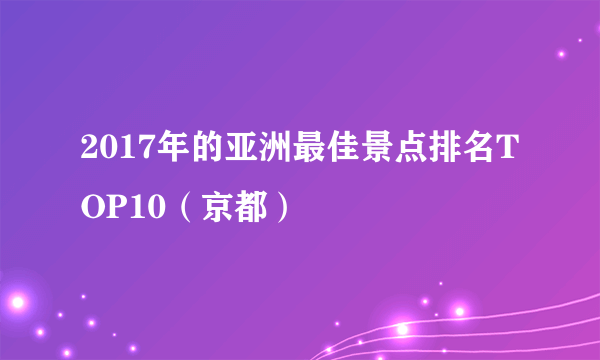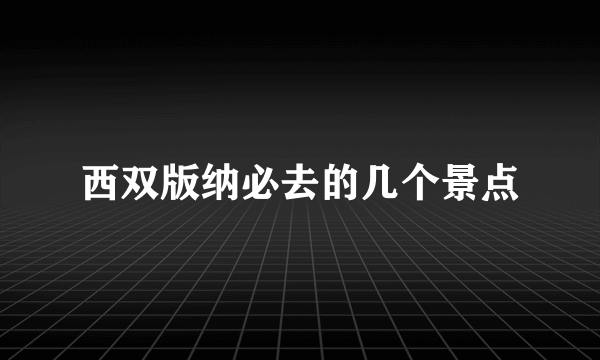2017年的亚洲最佳景点排名TOP10(京都)
的有关信息介绍如下:
日本的京都在2017年亚洲最佳景点排名中位列第10的位置,樱花花瓣微风吹佛,高雅的艺妓在木制茶室中来回穿梭,接下里跟着出国留学网的旅游编辑来详细了解一下吧,希望对您有帮助。
原因:为什么我们您去京都?前往这个前首都去体验日本和当代日本的混合体。京都是艺术和教育的中心,是从东京这样的超现代城市撤退的地方,当你去那里的时候一定要记得尊重习惯礼节。
亚洲最佳景点排名第十名:京都
一、京都纵览
Cherry blossom petals caught on a breeze, the burble of a water fountain permeating the silence of a peaceful rock garden, a pair of elegantly dressed geisha flitting between wooden tea houses ... Kyoto is the Japan of the past, the Japan of your imagination. Standing as Japan's capital from A.D. 794 to 1868, Kyoto has thrived as a hub for Japanese culture, art and education. Given the city's respect for its history, it's not surprising that millions of people visit Kyoto each year for a snapshot of imperial Japan.But no matter where you point your lens, modern-day Japan is sure to make it into the frame. Centuries-old Shinto shrines and pagodas share the city with the headquarters of companies like Nintendo and electronics manufacturer Kyocera. Kyoto's blend of ancient and contemporary makes it a vibrant city that certainly isn't stuck in the past. But if it's the past you seek, Kyoto will bring your imaginings to life.
樱花花瓣微风吹拂,一个喷泉中弥漫着宁静的岩石花园的寂静,一对穿着高雅的艺妓在木制茶室之间流淌......京都是过去的日本,你想象中的日本。作为日本从公元794年到1868年的首都,京都已经成为日本文化,艺术和教育的中心。考虑到这座城市对于历史的尊重,每年有数百万人访问京都拍摄日本的照片并不奇怪。但是无论你把镜头放在哪里,现代日本一定会把它放在镜框里。有数百年历史的神社和宝塔与任天堂和电子产品制造商京瓷公司的总部共用这座城市。京都融合了古代和现代,使其成为一个充满活力的城市,当然不会陷入过去。但是,如果这是你过去的追求,京都将把你的想象变成现实。
二、排名信息
#3 in Best Places to Visit in October
10月份最佳参观地点:第3名
#10 in Best Places to Visit in Asia
亚洲最佳地点:第10名
京都必去景点
1.伏见稻荷神社
关键信息:参观时间2小时至半天
As far as Shinto shrines go (there are about 400 in Kyoto), this one is pretty special. Perched on a wooded hillside in southern Kyoto, Fushimi Inari is a 1,300-year-old temple dedicated to Inari, the Shinto deity of rice and sake (Japanese rice wine). The shrine complex dates back to the 8th century, but it's not the star of the show. Most visitors come for the close to 10,000 red and orange lacquered torii gates that line the 2.5-mile-long path up Mount Inari, where the shrine sits. Sometimes in dense rows and other times more staggered, the gates are all engraved with the names of Shinto devotees who donated them.It takes about three hours to make the trek up the mountain, and some recent visitors say that the hike is mildly strenuous. But there are plenty of places to stop and rest along the way. Peer at the dozens of stone and bronze foxes that line the paths along with the gates (foxes are thought to be Inari's sacred messengers). Or stop in to one of the tea houses or restaurants situated on the path, which serve udon noodle soup and sushi. Because crowds are drawn to their picturesque beauty, Fushimi Inari's trails can get quite congested during the day. To avoid the multitudes, opt for an evening stroll up the mountain — recent visitors say the pervading quiet coupled with the fading light filtering through the trees and torii gates makes for an eerie and spiritual experience.
至于神社(在京都大约有400座),这个很特别。位于京都南部一处树木葱郁的山坡上,伏见稻荷神社是一座有1300年历史的寺庙,供奉着稻和清酒(日本米酒)的神仙。这座神社的历史可以追溯到8世纪,但它并不是这个展览的主角。大多数游客前来参观的都是近1万件红色和橙色的漆面漆,这条通道位于伊纳里山的2.5英里长的小路上,那里是神社的所在地。有时在密集的行里,有时更交错,门上刻着神道信徒的名字。徒步上山大约需要3个小时,最近的一些游客说,徒步旅行有点费力。但是沿途有很多地方可以停下来休息。凝视着沿着小路和大门的几十块石头和青铜狐狸(狐狸被认为是伏见稻荷神社的神圣使者)。或者到位于小路上的一家茶馆或餐馆里,那里有乌冬面汤和寿司。因为人们都被他们美丽如画的美景所吸引,所以在白天的时候,福岛的步道会变得非常拥挤。为了避开这些人群,选择傍晚在山上漫步——最近的游客们说,弥漫的宁静与逐渐消失的光线在树丛和鸟居之间形成了一种诡异的精神体验。福岛神社每天从日出到日落都可以自由参观和开放,在JR纳拉地铁线(位于京都火车站以南两站)的JR Inari站很容易到达。欲了解信息,请访问伏见稻荷神社网站(日语)。
2.清水寺
关键信息:参观时间2小时至半天
Situated on Otowa Mountain in eastern Kyoto, Kiyomizu Temple wows travelers with its stunning natural scenery, which visitors say is best viewed from the verandah off the temple's main building. The "stage," as it's called, sits atop huge pillars more than 40 feet above the hillside and affords visitors panoramas of the surrounding forest. Those views are even more beautiful in the spring when the cherry blossoms are in bloom or in the fall with the changing foliage. When you're done taking in the temple's surrounding beauty, you are invited to drink from the Otowa Waterfall, which gave the temple its name ("kiyomizu" means "pure water"). The waterfall is divided into three streams, each of which is said to bring longevity, academic success or love, respectively. But according to temple etiquette, drinking from all three streams is bad luck, so don't be greedy.
Also within in the complex is the Jishu Shrine, a red-lacquered temple dedicated to Okuninushi-no-mikoto, the Shinto god of love. Visitors who can successfully walk between two stones outside of the shrine with their eyes closed (the stones are about 20 feet apart) will supposedly have their love-related wishes granted. Along with toying with their fates, recent travelers also enjoy the souvenir shops found along the path to the temple. Many visitors insist that Kiyomizu Temple should be on every Kyoto traveler's to-do list, though one TripAdvisor user warns, "Go as early as possible in the morning because it becomes very crowded later in the day."Kiyomizu Temple opens at 6 a.m. every day of the year, and closes between 5:30 and 6:30 p.m. daily, depending on the season. On certain holidays, the temple hosts special night hours. For ordinary visiting hours, admission is 300 JPY (about $3 USD) for adults and 200 JPY (about $2 USD) for students. Special night admission costs 400 JPY (about $4 USD) for adults and 300 JPY (about $3 USD) for students. To get there, take bus No. 100 or 206 from Kyoto Station to Gojo-zaka or Kiyomizu-michi bus stops, which are both a ten-minute walk from the temple. For more information, visit Kiyomizu Temple's website.
清水寺坐落在京都东部的音羽山,清澈的自然景观令游客叹为观止,游客们最好从位于寺庙主楼外的阳台上观赏。所谓的“舞台”坐落在山坡上方40英尺以上的巨大柱子上,为游客提供周围森林的全景图。樱花盛开,秋天树叶变幻,春天更加美丽。当您完成了寺庙周围的美景时,您可以从音羽瀑布喝酒,这使得寺庙的名字(“kiyomizu”是指“纯净水”)。瀑布被分成三条河流,分别被称为长寿,学术成功或爱情。另外还有纪州神社,这是一座红漆神殿,献给爱神的神道之祭Okuninushi-no-mikoto。那些能够成功地在圣殿外面的两块石头之间走来走去的游客(相距约20英尺的石头),应该有他们的爱情愿望。除了玩命之外,最近的旅行者还可以沿着通向寺庙的路径找到纪念品商店。许多游客坚持认为清水寺应该在每一个京都旅行者的待办事项清单上,尽管有一位TripAdvisor用户警告说:“早点去早点去,因为当天晚些时候会变得非常拥挤。
清水寺在每年的每天上午6点开放,根据季节每天下午5点30分至6点30分关闭。在某些节假日,寺庙举办特别的夜间时间。普通上课时间入场费为成人300日元(约3美元),学生入场费200日元(约2美元)。特殊入场费用为成人400日元(约合4美元),学生为300日元(约合3美元)。为了到达那里,从京都站乘坐100号或206号巴士到五十坂或清水寺巴士站,这两个巴士站距离寺庙都只有十分钟的步行路程。欲了解信息,请访问清水寺



